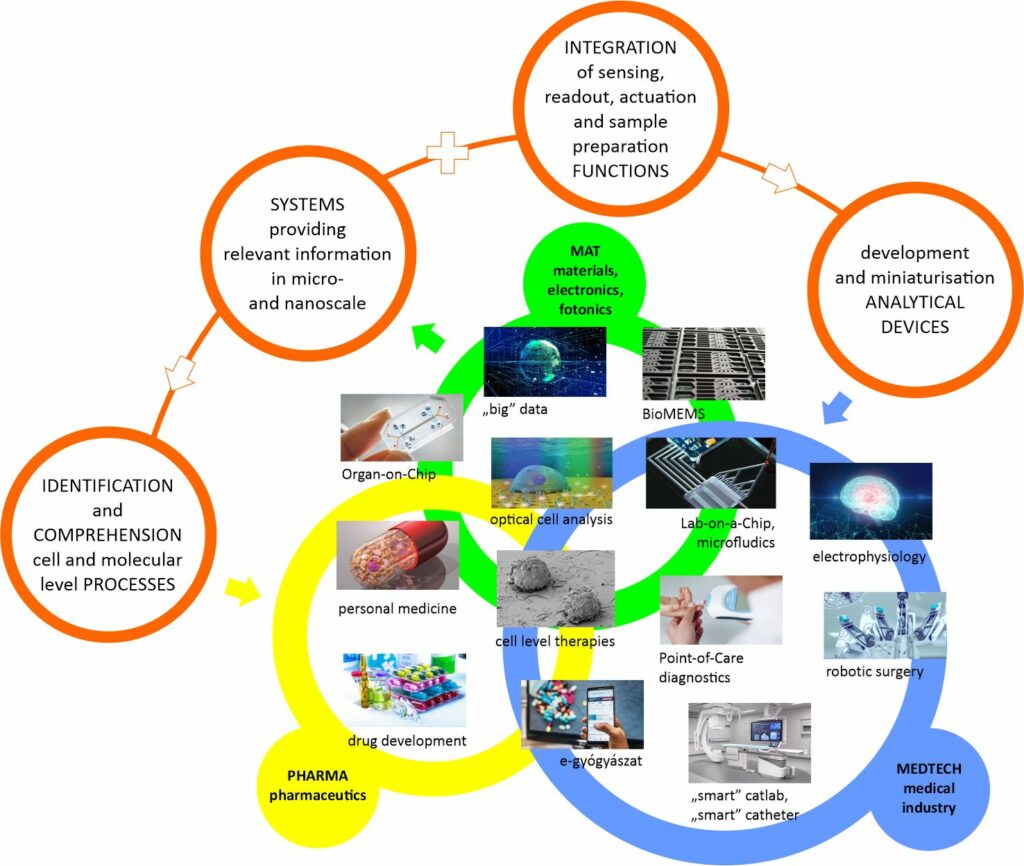By employing innovative solutions of micro- and nanotechnology, photonics, and sensing, researchers from the Institute of Technical Physics and Materials Science of the HUN-REN Centre for Energy Research are developing technologies and devices that can be the building blocks of new generation biosensors, combining highly sensitive analytical and efficient sample preparation functions. The aimed results are to support the competitiveness and expansion of the domestic biomedical and diagnostic industry.
Today, the most significant innovation solutions in medicine, medical technology, and pharmacology increasingly exploit the research and development results of Materials Science, Electronics, and Photonics. With the help of extreme miniaturization and the application of novel material systems, photonic and nanoelectronic solutions, completely new and complex sensing devices (Lab-on-a-Chip, Organ-on-Chip systems) can be offered to doctors and pharmacologists.
These integrated systems provide relevant information on micro- and nanoscale effects, and they enable the identification and understanding of basic cellular and molecular processes. Moreover, the development of modern analytical tools is also based on these new findings. These innovative technologies represent a huge step forward for the medical industry, advanced healthcare, and for the society as a whole.
In January 2022, the researchers of the Institute of Technical Physics and Materials Science of the HUN-REN Centre for Energy Research (EK MFA) started developments within the framework of the Thematic Excellence Program, with the aims to create highly sensitive, multifunctional, yet compact “smart” devices that can expand the possibilities of the medical technology and pharmaceutical industry, speeding up diagnostic decision-making, and drug testing.
By exploiting label-free optical biosensors and techniques suitable for selecting and manipulating individual cells, the researchers already achieved notable results in the field of basic biophysical phenomena. Among others, they worked on the development of cell screening methods, the development of novel biosensing principles, and the implementation of microfluidic structures for live cell manipulations:
- using label-free optical biosensors, they monitored the adhesion of cancer cells both at individual cell and population level and developed a new procedure for monitoring the invasion of cancer cells into compact cellular layers;
- microfluidically integrated nano-structured surfaces have been developed, which enable the analysis of particles, living cells, and active pharmaceutical ingredient at the molecular level, based on surface-enhanced Raman spectroscopy (SERS).
- microfluidic cuvettes compatible with UV-VIS spectroscopic and infrared spectro-ellipsometric measurement techniques were implemented for the purpose of detecting active pharmaceutical ingredients.
- investigated the applicability of target-specific continuous and digital microfluidic systems for size- and morphology-based sorting, trapping, and analysis of particles and cells,
- a microfluidic system suitable for the trapping and the impedance spectroscopy based analysis of cell populations and individual cells was developed for the evaluation of the effect of medicinal substances;
- new types of liquid cells and surface nanostructures were developed to investigate the surface adsorption of biomolecules: with their help, the sensitivity of the measurement of interface phenomena was investigated under different optical parameters, such as the wavelength, the angle of incidence or the thickness of the plasmonic layer;
The long-term goals of the researchers include, on one hand, the development and application of real-time, label-free optical (single) cell screening methods, and on the other hand, the understanding of the nanoscale biochemical and biophysical processes of cell populations – and thus disease mechanisms. During the development and pre-clinical testing of active pharmaceutical ingredients, impact tests on artificial cell cultures and tissues are of high importance. In the future, all these innovations in medical instruments can help drug development and daily diagnostic tasks, and provide novel technological solutions for fundamental medical research.

